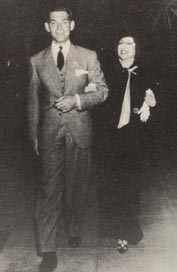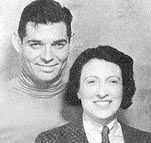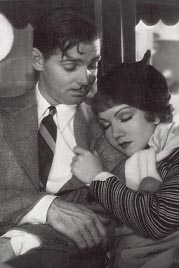
| 
first wife Josephine Dillon. |
It was clear from the start that this was not a union of love but rather one of convienence. Later, Clark once admitted that the marriage was never consumated. She did play a very important role in his life. For she was instrumental in transforming him into the Hollywood heartthrob that he later became. She fixed his teeth and taught him proper ediquette. It was Josephine who suggested that he drop his first name and use his middle name "Clark" instead. She did a lot of networking and landed him several bit roles in Silent Films. Due to his size and ruggedness, Clark was constantly over looked for leading roles. He became disenchanted with Hollywood, and Josephine, so he separated from her and in 1928 headed for the Broadway stages of New York.
Life in New York was no easier. He did some plays and hooked up with various traveling theatre troupes, but New York was changing as well. Soon Clark's luck began to turn. There became a demand for rugged leading men and Clark was there to answer the call. While on tour in Houston with a theatre company, he met wealthy socialite Mrs. Ria Langham. Although she was seventeen years his senior, the two became constant companions. She picked up where Josephine left off by smoothing out his rough edges and introducing him to influencial social crowds.

| 
tying the knot in 1930 |
1930 proved to be a big year for Clark. He and Ria married on March 30th just days after his divorce from Josephine was finalized. Clark ,also, got his first big break starring in the Los Angeles stage production of "The Last Mile" . In additon to gaining praise from the critics he also caught the eyes of many studio casting directors. Hollywood was looking and listening for new talent. Silent films were on their way out making way for the "talkies". Many Silent Screen matinee idols were cursed with deadly voices, thereby sealing their fate in cinema. He caught the eye of Warner Brothers head Daryl F. Zanuck who tested him for the lead in "Little Caesar". It was Zanuck who made the legendary comment: "His ears are too big, he looks like an ape". Needless to say, Clark didn't get the part. It, instead, went to Edward G. Robinson.
In 1931, Pathe Studios gambled with Gable by casting him in the medium budget Bill Boyd Western "The Painted Desert". He was paid $750 a week to play the villian. He had a commanding screen prescense and it didn't take long before Louis B. Mayor grabbed Clark for his stable. Clark went from an unknown extra to super star status in a matter of months. In 1931, alone, he made twelve films. It was a grueling schedule but Clark relished it. The boy from Ohio had finally made it BIG!! With the exceptions of some occasional loan outs to other studios, he remained under contract at MGM studios for the next twenty-three years.

|
Ironically, it was during a loan out to Columbia Studios that Clark gained his most success. In an attempt to punish Gable for refusing to play certain roles, he was sent to Columbia to be cast in the low budget Frank Capra movie "It Happened One Night".Much to MGM's surprise, and Clark's delight, the film was a box office hit and received the top five Academy Awards for 1934, including Best Actor for Gable. As a result of his newfound clout his salary at MGM rose to a whopping $4000 a week.


|